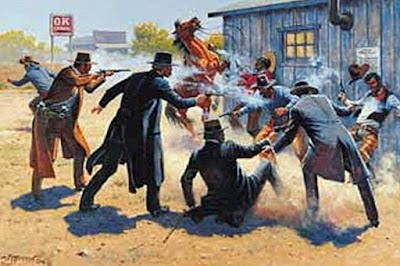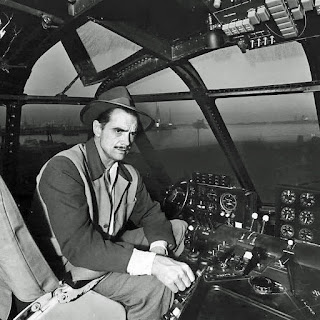HISTORY3 - Southeastern Arizona's Wild West
In my first group of history articles on this blog, I want to provide a
flavor of my recent writing that I collected and self-published in three
electronic books available for reading on my website, ringbrothershistory.com, under “Bob’s Projects.” This article is adapted from Southeastern
Arizona Reflections - Living History from the Wild West.
Over a period of a little more
than 25 years, from the late 1870s to the early 1900s, southeastern Arizona
earned its legendary reputation of being the “Wild West.” The time was characterized by fierce Apache
resistance, increased ranching operations, rapidly growing mining boom towns,
smuggling and cattle rustling across the U.S.-Mexico border, and a blooming
network of stagecoach lines and railroads.
Besides Apache raids across
southeastern Arizona until 1886, Cochise County, and particularly Tombstone,
was where most of southeastern Arizona’s Wild West action was. There was considerable tension between the
rural residents who were for the most part Democrats from the agrarian
Confederate States, and town residents and business owners who were largely
Republicans from the industrial Union States.
During the rapid growth of Cochise County in the 1880s, at the peak of
the silver mining boom, outlaws frequently robbed stagecoaches and brazenly
stole cattle in broad daylight. Between
1877 and 1882, bandits robbed 36 stagecoaches in southeastern Arizona.
In 1876, teenager Henry McCarty,
who would later be known as William H. Bonney and then Billy the Kid, fled to
territorial Arizona from New Mexico after stealing clothing and firearms, and
was hired as a ranch hand by Henry Hooker at the Sierra Bonita Ranch, north of Willcox. After murdering a blacksmith during an
altercation in 1877, McCarty returned to New Mexico, participated in the
Lincoln County War, and was eventually shot and killed by Sheriff Pat Garrett
in 1881.
Cattle rustlers from both the
U.S. and Mexico used the International border to raid across in one direction
and find sanctuary on the other side.
Bandits were even stealing horses from the Santa Cruz River Valley and
selling the livestock in Sonora, Mexico.
Mexican authorities complained about American outlaw Cowboys who stole
Mexican beef and resold it in Arizona.
The Clanton and McLaury clans were among those allegedly in the
cross-border livestock smuggling from Sonora into Arizona.
Note: A cowboy in that time and
that part of the country was generally regarded as an outlaw. Legitimate cowmen were referred to as cattle
herders or ranchers.
Between 1878 and 1881, there were
a number of deadly engagements along the border (including the First and Second
Skeleton Canyon Massacres, and the Guadalupe Massacre in the Peloncillo
Mountains) involving American Cowboys, Mexicans, or the Mexican militia - each
trying to get the upper hand in local smuggling and cattle rustling operations.
Shootings were commonplace,
especially in and around Tombstone. The
townspeople and business owners welcomed the Cowboys who spent money in the
numerous bordellos, gambling halls, and drinking establishments. As officers of the law, the five Earp
brothers (Wyatt, Virgil, Morgan, James, and Warren) held authority at times on
the federal, county, and local level.
They were resented by the Cowboys for their rough tactics, including
buffaloing drunken troublemakers. And
the lines between the outlaw element and law enforcement were not always
distinct.
Here are a few examples of the
Wild West mayhem that occurred over a three-and-a-half year period, during
Tombstone’s peak mining years:
In mid-June 1880, a drunken,
estranged husband shot at his rival on the porch of Tombstone’s Cosmopolitan
Hotel, but missed, and was in turn shot and killed by his rival.
On October 28, 1880, Tombstone
town marshal Fred White was trying to break up a group of late night revelers
shooting at the moon on Allen Street. He
attempted to confiscate the pistol of Cowboy Curly Bill Brocius and was shot
(supposedly accidentally) in the abdomen and later died.
On January 14, 1881, Tombstone
gambler Michael O’Rourke got into a disagreement with the chief engineer of the
Tombstone Mining and Milling Company and shot and killed him.
On February 28, 1881, Tombstone
professional gambler and gunfighter Charlie Storm was killed by Luke Short in
self-defense after being confronted by Storm for the second time that month.
On October 1, 1881, in nearby Charleston,
drunken James Hickey taunted and harassed gun fighter Billy Claiborne until
Claiborne shot and killed him.
The most famous shooting occurred
in Tombstone on October 26, 1881 when a group of lawmen led by Marshall Virgil
Earp and two brothers Wyatt and Morgan, plus the infamous John “Doc” Holiday,
tried to arrest five Cowboys for violating a city ordinance against carrying
weapons in town - in a confrontation that became known as the “Gunfight at the
OK Corral.” The lawmen prevailed, but
the Cowboys would seek revenge.
On December 28, 1881, Virgil Earp was shot-gunned and maimed while walking the streets of Tombstone.
On March 18, 1882, Morgan Earp
was shot through a window and killed while playing billiards in Tombstone.
On March 20, 1882 Cowboy Frank
Stillwell was killed by Wyatt Earp in Tucson, on Earp’s so-called Vendetta Ride
in retaliation for the shooting of Virgil and Morgan Earp.
On March 24, 1882, Curly Bill
Brocius was killed by Wyatt Earp in the Whetstone Mountains, about 20 miles
from Tombstone, also on Earp’s so-called Vendetta Ride.
On July 13, 1882, Cowboy and
gunman Johnny Ringo was shot near Chicauhua Peak. His death was ruled a suicide, but alternate
theories suggest Ringo was killed by Wyatt Earp, Doc Holiday, or others.
On November 14, 1882, Frank
Leslie became involved in an argument in Tombstone with Billy Claiborne who
shot at Leslie but missed, and was killed by Leslie who returned fire.
On February 23, 1883, in
Tombstone May Woodman shot and killed William Kinsman, who although living with
her at the time, had published his intentions not to marry her in the Tombstone
Epitaph newspaper.
On December 8, 1883, six outlaw
Cowboys robbed a Bisbee mercantile store, killing four people, later referred
to as the Bisbee Massacre. Six men were
arrested and convicted, and five of them were hanged on March 28, 1884 - the
first criminals to be legally hanged in Tombstone, then the county seat. The sixth outlaw was sentenced to life
imprisonment.
 |
| Grave marker in Tombstone's Boot Hill Cemetery for the five outlaws who were hanged for committing the Bisbee Massacre. (Courtesy of Wikimedia) |
With the onset of Tombstone’s mining difficulties in the mid 1880s, the pace of gunfights and outlawry slackened also.
But in 1886, Cochise County
Sheriff John Slaughter was chasing the Jack Taylor gang, wanted for robbery and
murder, who were visiting relatives in Tombstone. In the ensuing gunfight, at Contention City,
near Tombstone, two of the gang members were shot and killed. Two others escaped but were later killed in
Mexico.
As late as the early 1900s, there
were active outlaw gangs in southeastern Arizona. Former lawman Burt Alvord
resigned his post as a sheriff’s deputy in 1899 and together with partner Billy
Stiles, began a series of armed robberies, including train robberies. They were captured, escaped, and wounded, but
persisted until they were captured for the final time in Mexico in 1904.
Some towns became refuges for
outlaws of the day. One such town,
Galeyville, on the eastern edge of the Chiricahua Mountains, was a silver
mining site for a short period, before it busted, and became the home of a pack
of outlaws led by Curly Bill Brocius, who for a time was known as the outlaw
king of Cochise County. The mining town
of Pearce was, for a period, the home of the Alvord-Stiles gang.
With the rapid decline of
Tombstone in the late 1880s and the final surrender of Apache leader Geronimo
in 1886, the so-called Wild West started to wind down, and by the early 1900s,
had ceased to exist.




Comments
Post a Comment